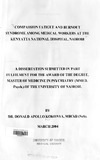| dc.description.abstract | The objective of this study was to establish the prevalence of and factors
associated with burnout syndrome and compassion fatigue among medical practitioners and
nurses at the Kenyatta National Hospital, Nairobi.
Descriptive and cross-sectional.
Prevalence rates, socio-demographic characteristics, factors associated
with and influencing burnout syndrome and compassion fatigue among the medical
practitioners and nurses at the Kenyatta National Hospital, Nairobi.
Proportionate Probability Sampling method was used to recruit medical
practitioners and nurses on the basis of qualifications, departments and distribution.
The crude prevalence rates of compassion fatigue were 29.6% while that for burnout
syndrome was 94.5%. The prevalence rate of compassion fatigue for medical practitioners
was 12.9% and 33.1% for the nurses. The prevalence rates for burnout were 96.7% for the
medical practitioners and 94.7% for the nurses. The risk factors found in this study for
burnout syndrome included being young or recently employed nurses, SHOs (5 times higher
than consultants), employed by the University of Nairobi, being in the age bracket 21-25
years, working as a practitioner for less than 16 years, being a nurse and married (p=0.033;
OR=0.79), a nurse graduate of middle college training, young medical practitioner and
carrying out bedside medicine and nursing. Working at KNH for more than 10 years
(p<O.OOOl;OR =0.21) and having been in the medical practice for more than 16 years among
the medical practitioners were found to be protective against burnout syndrome.
The factors found to be protective against burnout syndrome in this study included being a
medical practitioner (p=0.036), being an administrative and long experience nurse, a medical
practitioner employed by the Ministry of Health, Republic of Kenya (p<O.OOOl),being a
medical officer employed by Kenyatta National Hospital, being male (p=0.048), having
higher educational levels (p<0.0001; OR=0.56), a medical practitioner having worked for less
than 30 years and between 36 and 45 years, practising Protestant religious faith (p=0.014;
OR=0.87), a medical practitioner in orthopaedic surgery and dental departments and being a
consultant. Working at KNH for more than 10 years (p<O.OOO;OR=0.21) and practising
medicine more than 16 years.
Regression analysis for burnout syndrome showed that 'self-factors' contributed
14.0% for both medical practitioners and nurses equally. Patients and their relatives
contributed 42.0% for medical practitioners and 39.0% for nurses while work environment
contributed the largest proportion of 54.0% for medical practitioners and 57.0% for nurses.
The study found inverse relationship between compassion fatigue and burnout syndrome.
Burnout syndrome was established among nurses and medical practitioners at
KNH and the prevalence rate was higher than that found in other countries in the world. The
study also established that the syndrome had not been known to the study population before
and how it was influencing their outputs at work and at their personal functional levels. It was
found out by regression analysis that compassion fatigue did not influence burnout syndrome
among medical workers at KNH. | en |
| dc.description.department | a
Department of Psychiatry, University of Nairobi, ; bDepartment of Mental Health, School of Medicine,
Moi University, Eldoret, Kenya | |

